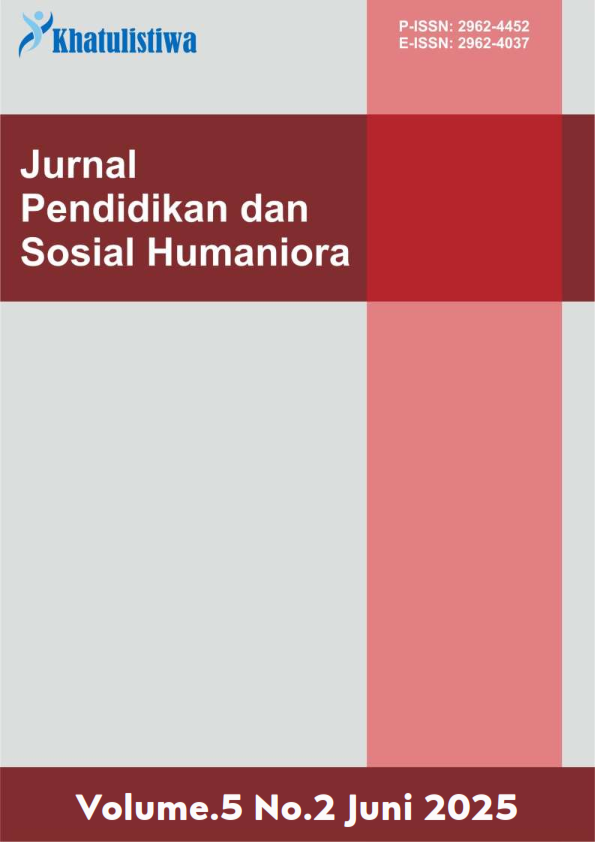Evaluasi Efektivitas Program Penanggulangan Kebakaran oleh Satuan Polisi Pamong Praja dan Pemadam Kebakaran Kabupaten Ngawi dalam Meningkatkan Perlindungan Masyarakat
DOI:
https://doi.org/10.55606/khatulistiwa.v5i2.5841Keywords:
community protection, fire management, firefighters, policy evaluation, program effectivenessAbstract
Fire is one of the serious threats that can disrupt the security, safety, and survival of the community, especially in areas with limited disaster management systems. Ngawi Regency as a developing area requires an effective fire management system to provide maximum protection to the community. This study aims to evaluate the effectiveness of the fire management program implemented by the Civil Service Police Unit and the Ngawi Regency Fire Department in improving community protection. This study uses a qualitative approach with a descriptive study type. Data were collected through in-depth interviews, participatory observation, and documentation. All data obtained were analyzed using the Miles and Huberman interactive analysis model, through the stages of data reduction, data presentation, and drawing conclusions. The results of the study indicate that the program is not yet fully effective, characterized by planning that is less based on risk data, uneven implementation across regions, and low socialization and community participation. The conclusion of this study states that the success of the program is highly dependent on adaptive planning, equitable distribution of resources, and active community involvement. For further research, it is recommended to develop an integrated quantitative and qualitative indicator-based evaluation model, as well as a comparative study between regions to obtain a broader picture of best practices in fire management at the regional level.
References
Andrew, M. (2018). Revisiting community-based disaster risk management. In Reducing Disaster Risks (pp. 42–52). Routledge.
Ariyani, N., Fauzi, A., Juanda, B., & Beik, I. S. (2016). Evaluasi pogram pengentasan kemiskinan menggunakan metode rappoverty. Jurnal Ekonomi Dan Kebijakan Publik, 6(2), 181–197.
Cahyani, N., Zahran, W. S., & Irwansyah, I. (2021). Efektivitas Sosialisasi Pencegahan Kebakaran Bangunan Rumah Dan Lahan Pada Masyarakat Di Permukiman Padat Penduduk (Studi Kasus Di Kecamatan Bekasi Utara, Periode Tahun 2021). Jurnal Ilmu Administrasi Publik, 2(4), 390–397.
Dunn, W. N. (2003). Pengantar Analisis Kebijakan Publik. Gadjah Mada University Press.
Erna, Y., Lionardo, A., & Wulandari, N. (2024). Efektivitas Program Rehabilitasi dan Rekonstruksi Pasca Bencana pada Badan Penanggulangan Bencana Daerah Kabupaten Pali. Journal of Law & Policy Review, 2(1), 139–146.
Fernandes, A. A. R., & Panjaitan, R. B. (2019). The effect of community and company participation and implementation of good forest fire governance on the forest fire policy in Indonesia. Journal of Science and Technology Policy Management, 10(1), 102–115.
Fultanegara, A. A., & ASNAWI, A. (2014). PENGEMBANGAN KAPASITAS KELEMBAGAAN LOKAL DAN TINGKAT REALISASI PROGRAM PENATAAN LINGKUNGAN PERMUKIMAN DI PERKOTAAN (Studi Kasus: Program PLPBK di Kabupaten Kendal dan Kota Pekalongan). UNIVERSITAS DIPONEGORO.
Liu, W., Dugar, S., McCallum, I., Thapa, G., See, L., Khadka, P., & Shakya, P. (2018). Integrated participatory and collaborative risk mapping for enhancing disaster resilience. ISPRS International Journal of Geo-Information, 7(2), 68.
Mishra, S., & Mazumdar, S. (2022). Promoting community resilience through disaster education. PLOS ONE, 17(12), e0276393.
Mustafid, H. (2017). Peningkatan kinerja aparatur sipil negara melalui budaya organisasi. Tarbawi: Jurnal Keilmuan Manajemen Pendidikan, 3(01), 1–14.
Pattimahu, Z. (2021). KAPASITAS DAN KETAHANAN MASYARAKAT DALAM MENGHADAPI ANCAMAN BENCANA KEBAKARAN (STUDI KASUS: PULAU BARRANG LOMPO, KOTA MAKASSAR)= COMMUNITY CAPACITY AND RESILIENCE IN FACING THE THREAT OF FIRE DISASTER (CASE STUDI: BARRANG LOMPO ISLAND, MAKASSAR CITY). Universitas Hasanuddin.
Ratheesh Mon, P., & Sekher, T. V. (2022). Spatial (in) Justice and Vulnerable Communities: A Study on the Landslide Susceptibility of Dalits in Idukki District, Kerala. International Geographical Union Thematic Conference, 407–419.
Seftyarizki, D., Ramawangsa, P. A., & Saputri, D. O. (2019). Evaluasi jalur evakuasi bencana kebakaran pada sirkulasi gedung serbaguna UNIB. Jurnal Manajemen Aset Infrastruktur & Fasilitas, 3.
Simatupang, P., & Akib, H. (2011). Efektivitas implementasi dan dampak kebijakan dalam konteks desentralisasi pemerintahan. Jurnal Ilmiah Ilmu Administrasi Publik, 2(1).
Sufardi, I., Sunarto, S., & Abduh, M. (2024). Evaluasi Kinerja Personil dalam Upaya Penanggulangan Kejadian Kebakaran (Studi Kasus Posko Kemuning pada Dinas Pemadam Kebakaran dan Penanggulangan Bencana Kota Palembang). Eksekusi: Jurnal Ilmu Hukum Dan Administrasi Negara, 2(4), 72–88.
Tam, W. J., & Peh, R. (2025). 33. Successful risk communication and community engagement. In Infectious Disease Emergencies: Preparedness and Response.
Torfing, J. (2013). Collaborative innovation in the public sector. In Handbook of innovation in public services (pp. 301–316). Edward Elgar Publishing.
Wahyuni, Y. T., & Manaf, A. (2016). Partisipasi Masyarakat dan Keberlanjutan Program Gerak Bersemi di Griya Prima Lestari Munthe Kabupaten Kutai Timur. Jurnal Pembangunan Wilayah Dan Kota, 12(4), 472–482.
Yuliana, E. H., Rohayatin, T., & Aprilia, B. (2024). EFEKTIVITAS PROGRAM BADAN PENANGGULANGAN DAERAH DALAM PENCEGAHAN DAN MITIGASI BENCANA BANJIR DI KABUPATEN SERANG. Jurnal Praxis Idealis: Jurnal Mahasiswa Ilmu Pemerintahan, 1(1).
Downloads
Published
How to Cite
Issue
Section
License
Copyright (c) 2025 Khatulistiwa: Jurnal Pendidikan dan Sosial Humaniora

This work is licensed under a Creative Commons Attribution-ShareAlike 4.0 International License.








